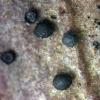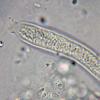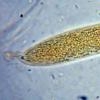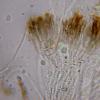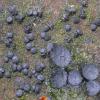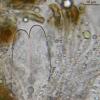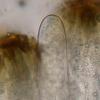
16-03-2009 23:09
 Yannick Mourgues
Yannick Mourgues
Bonsoir à tous. Voici une chose curieuse trouv

14-03-2009 00:20
Roland LabbéVoici une planche d'un Discomycète blanc inconnu.

11-03-2009 22:48
 Hans-Otto Baral
Hans-Otto Baral
Hi I have here a pyreno with unitunicate asci t

11-03-2009 16:58
Guy GarciaEst-ce que ça cadre pour Lentomitella cirrhosa ?

11-03-2009 00:00
 Miguel Ángel Ribes
Miguel Ángel Ribes
Buenas noches Tengo varias recolecciones de Lac
Tympanis
Jean Pierre Dechaume,
20-03-2009 18:53
 Chers amis,
Chers amis,Sur branche morte de Pinus strobus trempant dans un ruisseau, sur l'écorce, fructifications plutôt isolées de 1mm de diam, pulvinées surélévées, puis en tartelettes en séchant.
Paraphyses ramifiées septées coiffées de brun.
Conidies en saucisses, hyalines 2x1 microns.
iode douteux.
Qu'en pensez-vous?
Nous n'avons aucune expérience des Tympanis. Et c'est dans Ellis que nous avons vu ce Tympanis hypopodia, possible...
Merci de nous éclairer.
jean pierre
Christian Lechat,
20-03-2009 19:05

Re:Tympanis
je penserais plutôt pour un Karschia
amitiés,
Christian
amitiés,
Christian
Hans-Otto Baral,
20-03-2009 20:01

Re:Tympanis
No, Christian, this is a Tympanis, and possibly T. hypopodia/confusa. I have a recent collection, also on Pinus strobus bark, from Chemnitz (E-Germany), which is surely the same. Typical of the genus is the oil-like matter between the hyaline part of the paraphyses (but this is also present in Patellaria atrata).
Zotto
Zotto
Hans-Otto Baral,
20-03-2009 20:02
Hans-Otto Baral,
20-03-2009 20:02
Jean Pierre Dechaume,
20-03-2009 23:16

Re:Tympanis
Merci Messieurs de vos avis,
je vais me faire traduire précisément ce que dit Zotto...
Je n'ai pas encore réussi à voir les spores primaires.
Un jour peut-être.
Bonsoir
jean pierre
je vais me faire traduire précisément ce que dit Zotto...
Je n'ai pas encore réussi à voir les spores primaires.
Un jour peut-être.
Bonsoir
jean pierre
